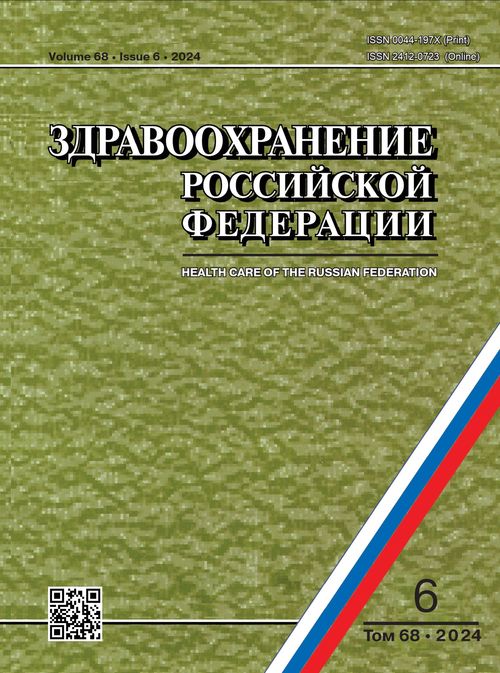Полиморфизмы 836A>G гена MMP9 и -174G/С гена IL-6, ассоциированные с риском развития аллергических заболеваний у детей
- Авторы: Старкова К.Г.1, Долгих О.В.1, Легостаева Т.А.1
-
Учреждения:
- ФБУН «Федеральный научный центр медико-профилактических технологий управления рисками здоровью населения» Федеральной службы по надзору в сфере защиты прав потребителей и благополучия человека
- Выпуск: Том 68, № 6 (2024)
- Страницы: 505-510
- Раздел: ЗДОРОВЬЕ ДЕТЕЙ И ПОДРОСТКОВ
- Статья получена: 14.01.2025
- URL: https://hum-ecol.ru/0044-197X/article/view/646183
- DOI: https://doi.org/10.47470/0044-197X-2024-68-6-505-510
- EDN: https://elibrary.ru/xpibab
- ID: 646183
Цитировать
Полный текст
Аннотация
0000-0002-1368-9703
Ключевые слова
Об авторах
Ксения Геннадьевна Старкова
ФБУН «Федеральный научный центр медико-профилактических технологий управления рисками здоровью населения» Федеральной службы по надзору в сфере защиты прав потребителей и благополучия человека
Email: skg@fcrisk.ru
ORCID iD: 0000-0002-5162-9234
Канд. биол. наук, зав. лабораторией иммунологии и аллергологии ФБУН «ФНЦ медико-профилактических технологий управления рисками здоровью населения» Роспотребнадзора, 614045, Пермь, Россия
e-mail: skg@fcrisk.ru
Олег Владимирович Долгих
ФБУН «Федеральный научный центр медико-профилактических технологий управления рисками здоровью населения» Федеральной службы по надзору в сфере защиты прав потребителей и благополучия человека
Email: oleg@fcrisk.ru
ORCID iD: 0000-0003-4860-3145
Доктор мед. наук, профессор, зав. отделом иммунобиологических методов диагностики, ФБУН «ФНЦ медико-профилактических технологий управления рисками здоровью населения» Роспотребнадзора, 614045, Пермь, Россия
e-mail: oleg@fcrisk.ru
Татьяна Андреевна Легостаева
ФБУН «Федеральный научный центр медико-профилактических технологий управления рисками здоровью населения» Федеральной службы по надзору в сфере защиты прав потребителей и благополучия человека
Автор, ответственный за переписку.
Email: ms.legota@mail.ru
ORCID iD: 0000-0002-1368-9703
Врач клинической лабораторной диагностики ФБУН «ФНЦ медико-профилактических технологий управления рисками здоровью населения» Роспотребнадзора, 614045, Пермь, Россия
e-mail: ms.legota@mail.ru
Список литературы
- Long A., Bunning B., Sampath V., DeKruyff R.H., Nadeau K.C. Epigenetics and the environment in airway disease: asthma and allergic rhinitis. Adv. Exp. Med. Biol. 2020; 1253: 153–81. https://doi.org/10.1007/978-981-15-3449-2_6
- Nanda A., Mustafa S.S., Castillo M., Bernstein J.A. Air pollution effects in allergies and asthma. Immunol. Allergy Clin. North. Am. 2022; 42(4): 801–15. https://doi.org/10.1016/j.iac.2022.06.004
- Ogulur I., Pat Y., Ardicli O., Barletta E., Cevhertas L., Fernandez-Santamaria R., et al. Advances and highlights in biomarkers of allergic diseases. Allergy. 2021; 76(12): 3659–86. https://doi.org/10.1111/all.15089
- Зайцева Н.В., Землянова М.А., Чащин В.П., Гудков А.Б. Научные принципы применения биомаркеров в медико-экологических исследованиях (обзор литературы). Экология человека. 2019; (9): 4–14. https://doi.org/10.33396/1728-0869-2019-9-4-14 https://elibrary.ru/wswnqj
- Тийс Р.П., Осипова Л.П. Интерлейкин-6: его роль в организме, генетический полиморфизм и значение при некоторых заболеваниях (литературный обзор). Медицинская генетика. 2022; 21(1): 14–27. https://doi.org/10.25557/2073-7998.2022.01.14-27 https://elibrary.ru/wvcnmu
- Maqsood R., Iqbal H., Gul S., Ali I., Malik J. Expression and clinical significance of IL-6 in patients with allergic rhinitis. Int. J. Otorhinolaryngol. Head Neck Surg. 2023; 9(2): 165–8. https://doi.org/10.18203/issn.2454-5929.ijohns20230103
- Шадрина А.С., Плиева Я.З., Кушлинский Д.Н., Морозов А.А., Филипенко М.Л., Чанг В.Л. и др. Классификация, регуляция активности, генетический полиморфизм матриксных металлопротеиназ в норме и при патологии. Альманах клинической медицины. 2017; 45(4): 266–79. https://doi.org/10.18786/2072-0505-2017-45-4-266-279 https://elibrary.ru/zcquyh
- Семерник О.Е., Лебеденко А.А., Аппоева А.А. Металлопротеиназа-9 и ее роль в патогенезе аллергических заболеваний у детей. Медицинская иммунология. 2023; 25(5): 1027–32. https://doi.org/10.15789/1563-0625-MAI-2721 https://elibrary.ru/wpiohy
- Choi B.Y., Han M., Kwak J.W., Kim T.H. Genetics and epigenetics in allergic rhinitis. Genes (Basel). 2021; 12(12): 2004. https://doi.org/10.3390/genes12122004
- Kabesch M., Tost J. Recent findings in the genetics and epigenetics of asthma and allergy. Semin. Immunopathol. 2020; 42(1): 43–60. https://doi.org/10.1007/s00281-019-00777-w
- Babusikova E., Jurecekova J., Jesenak M., Evinova A. Association of gene polymorphisms in interleukin 6 in infantile bronchial asthma. Arch. Bronconeumol. 2017; 53(7): 381–6. https://doi.org/10.1016/j.arbres.2016.09.012
- Li T., Zhang X., Sang L., Li X.T., Sun H.Y., Yang J., et al. The interaction effects between TLR4 and MMP9 gene polymorphisms contribute to aortic aneurysm risk in a Chinese Han population. BMC Cardiovasc. Disord. 2019; 19(1): 72. https://doi.org/10.1186/s12872-019-1049-8
- Yang Y., Xiao J., Tang L., Wang B., Sun X., Xu Z., et al. Effects of IL-6 polymorphisms on individual susceptibility to allergic diseases: a systematic review and meta-analysis. Front. Genet. 2022; 13: 822091. https://doi.org/10.3389/fgene.2022.822091
- Gao S., Yu L., Zhang J., Li X., Zhou J., Zeng P., et al. Expression and clinical significance of VCAM-1, IL-6, and IL-17A in patients with allergic rhinitis. Ann. Palliat. Med. 2021; 10(4): 4516–22. https://doi.org/10.21037/apm-21-546
- Naik S.P., Mahesh P.A, Jayaraj B.S., Madhunapantula S.V., Jahromi S.R., Yadav M.K. Evaluation of inflammatory markers interleukin-6 (IL-6) and matrix metalloproteinase-9 (MMP-9) in asthma. J. Asthma. 2017; 54(6): 584–93. https://doi.org/10.1080/02770903.2016.1244828
- Akbari T., Kazemi Fard T., Fadaei R., Rostami R., Moradi N., Movahedi M., et al. Evaluation of MMP-9, IL-6, TNF-α levels and peripheral blood mononuclear cells genes expression of MMP-9 and TIMP-1 in Iranian patients with coronary artery disease. J. Cardiovasc. Thorac. Res. 2023; 15(4): 223–30. https://doi.org/10.34172/jcvtr.2023.31844
- Zou F., Zhang J., Xiang G., Jiao H., Gao H. Association of matrix metalloproteinase 9 (MMP-9) polymorphisms with asthma risk: a meta-analysis. Can. Respir. J. 2019; 2019: 9260495. https://doi.org/10.1155/2019/9260495
- Маркелова Е.В., Здор В.В., Романчук А.Л., Бирко О.Н. Матриксные металлопротеиназы: их взаимосвязь с системой цитокинов, диагностический и прогностический потенциал. Иммунопатология, аллергология, инфектология. 2016; (2): 11–22. https://doi.org/10.14427/jipai.2016.2.23 https://elibrary.ru/weatpt
- Bajbouj K., Ramakrishnan R.K., Hamid Q. Role of matrix metalloproteinases in angiogenesis and its implications in asthma. J. Immunol. Res. 2021; 2021: 6645072. https://doi.org/10.1155/2021/6645072
- Cui N., Hu M., Khalil R.A. Biochemical and biological attributes of matrix metalloproteinases. Prog. Mol. Biol. Transl. Sci. 2017; 147: 1–73. https://doi.org/10.1016/bs.pmbts.2017.02.005
Дополнительные файлы









